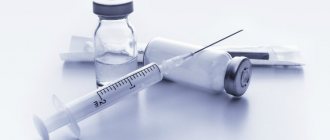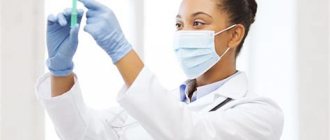Indications for vaccination "Measles"
Planned and emergency prevention of measles:
Routine vaccinations are carried out twice at the ages of 12 months and 6 years for children who have not had measles. Children born from mothers seronegative for the measles virus are vaccinated at the age of 8 months and then at 14-15 months and 6 years. The interval between vaccination and re-vaccination must be at least 6 months.
Children aged 1 year to 18 years inclusive and adults up to 35 years old inclusive, who have not been vaccinated previously, who do not have information about vaccinations against measles, who have not previously had measles, are vaccinated in accordance with the instructions for use twice with an interval of at least 3 months between vaccinations.
Persons previously vaccinated once are subject to a single immunization with an interval of at least 3 months between vaccinations.
Compatibility with other vaccines
Vaccination against measles can be carried out simultaneously (on the same day) with other vaccinations of the National Preventive Vaccination Calendar (against mumps, rubella, polio, hepatitis B, whooping cough, diphtheria, tetanus) or no earlier than 1 month after the previous vaccination. After the administration of human immunoglobulin preparations, vaccinations against measles are carried out no earlier than 3 months later. After the administration of measles vaccine, immunoglobulin preparations can be administered no earlier than 2 weeks later. If it is necessary to use immunoglobulin earlier than this period, measles vaccination should be repeated.
After immunosuppressive therapy, measles vaccination can be carried out 3-6 months after the end of treatment.
Measles vaccine cultural live dry
FSUE NPO Microgen, Ministry of Health of the Russian Federation, Russia
Release form: 1 ampoule / 1 dose No. 10.
Vaccination schedule: Routine vaccinations are carried out twice for children aged 12 months and 6 years who have not had measles. Emergency prophylaxis is carried out for children from 12 months, adolescents and adults who have been in contact with measles patients and have not previously been vaccinated against this infection.
INSTRUCTIONS FOR USE Dry measles culture vaccine
Lyophilisate for the preparation of solution for subcutaneous administration
The measles vaccine is prepared by cultivating the attenuated strain of measles virus Leningrad-16 (L-16) on a primary cell culture of quail embryos. The drug is a homogeneous mass of pink color, hygroscopic.
Composition One vaccination dose contains: - at least 1000 TCD50 (tissue cytopathogenic doses) of measles virus, - stabilizer: 0.04-0.08 ml LS-18 and 0.001-0.002 g of gelatin, - antibiotic - gentamicin sulfate or kanamycin sulfate, no more 20 mcg.
Immunological properties The vaccine stimulates the production of antibodies to the measles virus, reaching a maximum level 3-4 weeks after vaccination.
Purpose The measles vaccine is intended for routine and emergency prevention of measles. Routine vaccinations are carried out twice at the age of 12-15 months and 6 years for children who have not had measles. Children born from mothers seronegative for the measles virus are vaccinated at the age of 8 months and beyond - in accordance with the vaccination schedule. The interval between vaccination and re-vaccination must be at least 6 months. Emergency prophylaxis is carried out for children from 12 months of age, adolescents and adults who have had contact with a person with measles, who have not had measles and have not previously been vaccinated against this infection. In the absence of contraindications, the vaccine is administered no later than 72 hours after contact with the patient.
Contraindications
- severe forms of allergic reactions to aminoglycosides (gentamicin sulfate, etc.) and chicken eggs;
- primary immunodeficiency conditions, malignant blood diseases and neoplasms;
- severe reaction (temperature rise above 40° C, swelling, hyperemia more than 8 cm in diameter at the site of vaccine administration) or a complication to the previous dose;
- pregnancy.
Note HIV infection is not a contraindication to vaccination.
Prevention Vaccinations are carried out: - after the end of acute manifestations of infectious and non-infectious diseases; - immediately after normalization of temperature in non-severe forms of ARVI, acute intestinal diseases; — after immunosuppressive therapy, vaccination is carried out 3-6 months after the end of treatment;
Vaccination against measles can be carried out simultaneously (on the same day) with other calendar vaccinations (against mumps, polio, hepatitis B, whooping cough, diphtheria, tetanus) or no earlier than 1 month after the previous vaccination.
After the administration of human immunoglobulin preparations, vaccination against measles is carried out no earlier than 2 months later. After the administration of measles vaccine, immunoglobulin preparations can be administered no earlier than 2 weeks; If it is necessary to use immunoglobulin earlier than this period, measles vaccination should be repeated. If measles antibodies are present in the blood serum, re-vaccination is not carried out.
Persons temporarily exempt from vaccinations should be monitored and vaccinated after the contraindications are lifted.
Method of administration and dosage Immediately before use, the vaccine is diluted with the supplied solvent at the rate of 0.5 ml of solvent per one vaccination dose of the vaccine. The vaccine should completely dissolve within 3 minutes. The dissolved vaccine appears as a clear pink liquid. The vaccine is administered subcutaneously in a volume of 0.5 ml under the shoulder blade or in the shoulder area (at the border between the lower and middle third of the shoulder from the outside). The dissolved vaccine is used immediately and cannot be stored.
Reaction to administration In most children, the vaccination process is asymptomatic. Some children from 6 to 18 days may experience temperature reactions, mild hyperemia of the pharynx, and rhinitis; less often - coughing and conjunctivitis, lasting for 1-3 days. In isolated cases, mild malaise and a measles-like rash are observed. Local reactions are usually absent. In rare cases, slight skin hyperemia and mild swelling develop, which disappear after 1-3 days without treatment. Extremely rare - convulsive reactions that occur, most often, 6-10 days after vaccination, usually against a background of high temperature, and allergic reactions that occur in the first 24-48 hours in children with allergic altered reactivity.
Note A history of febrile convulsions, as well as an increase in temperature above 38.5°C in the post-vaccination period, is an indication for the prescription of antipyretics.
Release form Ampoules of 1, 2 and 5 vaccination doses. The package contains 10 ampoules.
Storage conditions Storage at temperatures from 0 to 8 °C. Shelf life : 15 months.
← Back
Contraindications
Only a doctor can decide whether Measles is suitable for vaccination
The Measles vaccine is contraindicated if there is a history of an allergic reaction to any component of the vaccine, and in the following cases:
- Severe forms of allergic reactions to aminoglycosides (gentamicin sulfate, etc.), chicken and/or quail eggs.
- Primary immunodeficiency conditions, malignant blood diseases and neoplasms.
- Severe reaction (temperature rise above 40 C, swelling, hyperemia more than 8 cm in diameter at the injection site) or complication to a previous administration of measles or mumps-measles vaccines.
- Pregnancy.
What components may be contained in modern vaccines?
There are different classifications of drugs for active immunization:
Live with an artificially weakened pathogen
The immune system sees the pathogen in much the same way as a real virus or bacterium. The difference is that it cannot cause disease, because to the extent that it has ceased to be pathogenic. This type of “live” vaccines includes drugs against the following infections: polio (oral vaccine), tuberculosis (BCG vaccine), rubella, measles, mumps, chickenpox, brucellosis, Q fever, etc.
Killed (inactivated)
This case differs from the first only in that the infectious agent is no longer alive and contains killed whole microorganisms (bacteria and viruses) or their parts.
Note:
When it comes to viruses, it is incorrect to talk about a “live” or “dead” virus, because, from the point of view of science, viruses are not something living. It is more correct to talk about virulent ones, i.e. capable of infecting and causing a full-fledged disease, and inactivated - not capable of causing a disease, but sufficient to develop an immune response. For convenience, we will call them alive/killed, especially since this expression has already become firmly established in everyday life.
Examples of inactivated vaccines: against whooping cough (whole cell), against polio (IPV), etc.
Anatoxins
These drugs contain neutralized (inactivated) bacterial toxins that are immunogenic and non-toxic. They are no longer poisonous to the body, but are still capable of causing an immune response. Vaccines are made based on toxoids, for example, against diphtheria, tetanus, whooping cough (a vaccine with an acellular pertussis component).
Note:
An interesting fact is that with natural infection with tetanus, immunity to it is not formed. Because the toxin content in the blood is not enough to form immune memory, and a higher concentration leads to death. In this case, an inactivated toxin is the only opportunity to gain immunity and not be afraid of this infection.
Artificial antigens
The material for creating artificial antigens is recombinant proteins or their fragments synthesized in laboratories using genetic engineering methods. In this case, the vaccine developer acts as an engineer of the design that will be administered to the patient.
To create such a vaccine, it is necessary to go through several stages of development: - first, one of the pathogen proteins is selected to which the immune system responds well; — in the laboratory, a specially “trained” cell culture is created, which will produce this protein according to instructions (gene modification is carried out by inserting a sequence encoding the desired protein into the genome of the producing cells); — provide this culture with everything necessary for the modified cell to actively multiply and produce antigens for the vaccine;
- after some time, they “harvest” by isolating the desired protein from the solution.
An analogy can be drawn with the process of conventional fermentation. That is, “yeast” will act as that specially trained cell culture, and “alcohol” will act as the desired substance that we want to obtain from these cells. Fruit or sugar is food for yeast. The difference is that yeast “knows how” to produce alcohol, but antigens, for example, for a vaccine against viral hepatitis B, do not.
The peculiarity of vaccines with artificial antigens is that they do not contain the real infectious agent at all. Relatively speaking, part of the virus was printed many times on a 3D printer, i.e. cloned.
Examples of such vaccines: against the hepatitis B virus, against the human papillomavirus (HPV).
Possible side effects
- In most vaccinated people, the post-vaccination period is asymptomatic.
- In the period from 6 to 18 days after vaccination, temperature reactions, mild hyperemia of the pharynx, and rhinitis may be observed.
- Rarely, coughing and conjunctivitis are observed, lasting for 1-3 days, minor skin hyperemia and mild swelling, which disappear after 1-3 days without treatment.
- Very rarely, 6-10 days after vaccination, mild malaise and a measles-like rash and convulsive reactions occur, most often occurring against a background of high fever.
- In the first two days, allergic reactions may be observed in children with allergic altered reactivity.
- A history of febrile convulsions, as well as an increase in temperature above 38.5 ºC in the post-vaccination period, are an indication for the prescription of antipyretics.
- Considering the possibility of developing immediate allergic reactions (anaphylactic shock, Quincke's edema, urticaria) in particularly sensitive individuals, vaccinated persons must be provided with medical supervision for 30 minutes.
Come get vaccinated at MAMARADA. A full range of vaccines for children and adults, family vaccinations - at a special price!
How to prepare your child for vaccination
For successful immunization and minimizing side effects, the baby must be prepared in advance and follow some rules before and after vaccination:
- It is necessary to undergo an examination by a pediatrician and neurologist in advance. Possible reasons for delaying vaccination include: acute viral and bacterial diseases, severe anemia, high fever, etc. After eliminating the acute form of the disease, immunization is carried out according to the course;
- Before and after vaccination, it is advisable not to feed the baby until he asks. Do not give heavy food for several days after the injection;
- If inflammation develops at the injection site, immediately consult a supervising doctor;
- It is not advisable to walk for a long time after vaccination;
- Avoid hypothermia and overheating;
- Prepare in advance for a possible increase in temperature (have paracetamol or ibuprofen at home). Fever is a predicted reaction to vaccination. But it should not be too high (40° C or more);
- After the injection, do not leave the Medical Center for at least 30 minutes.
All the vaccines we use comply with WHO standards, which guarantees their effectiveness, safety and reduced risk of side effects.





